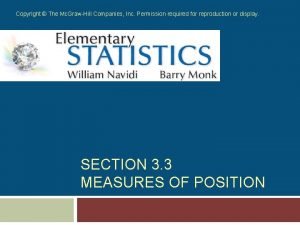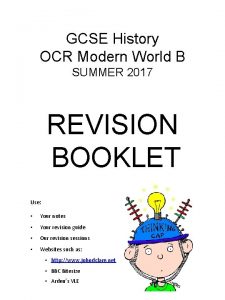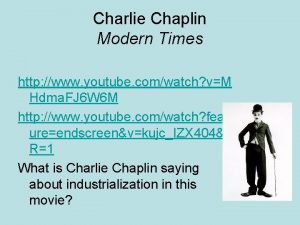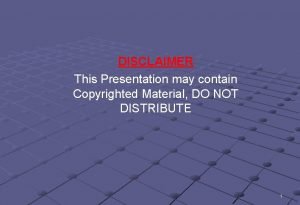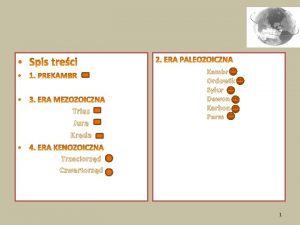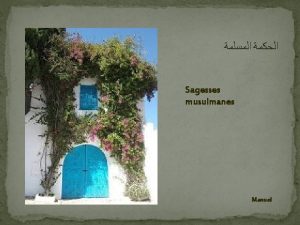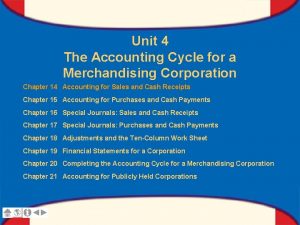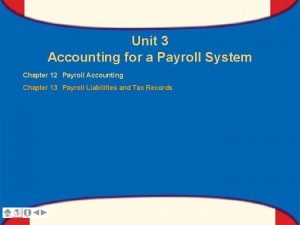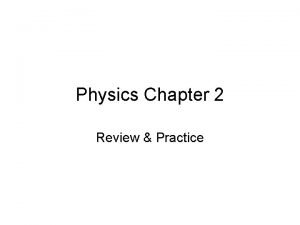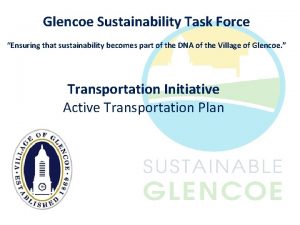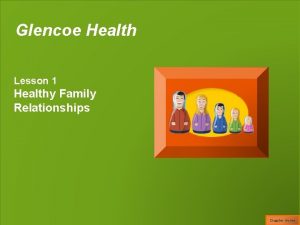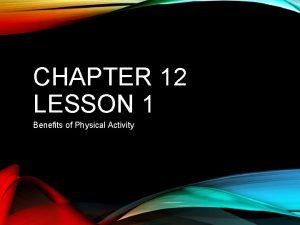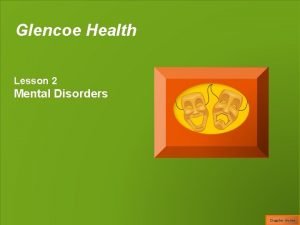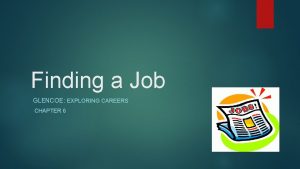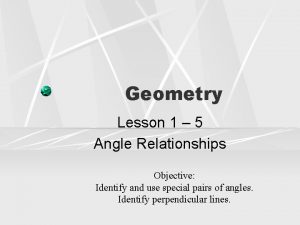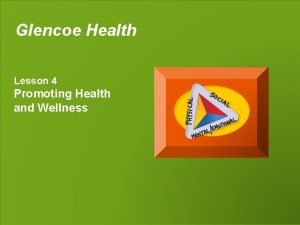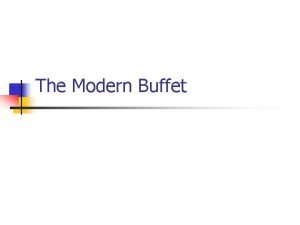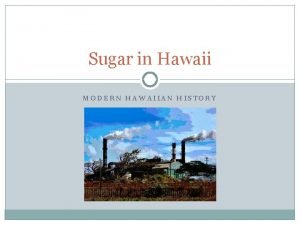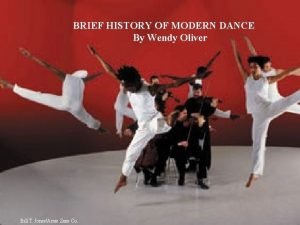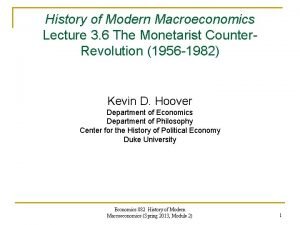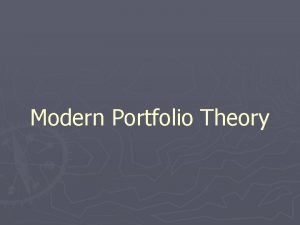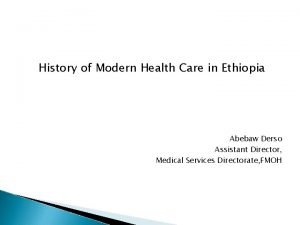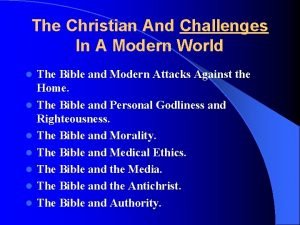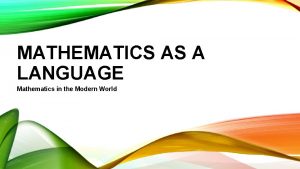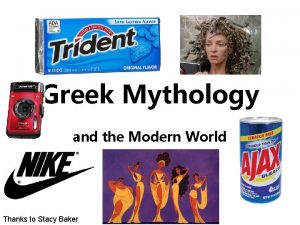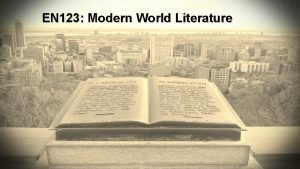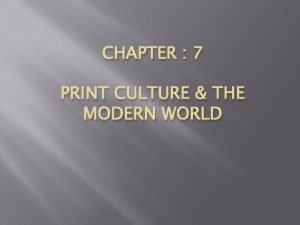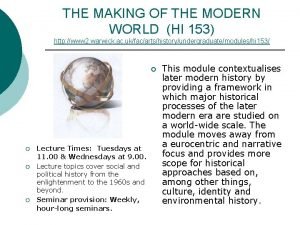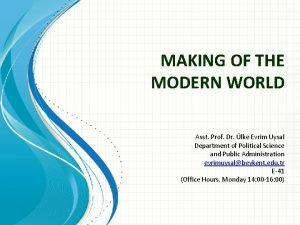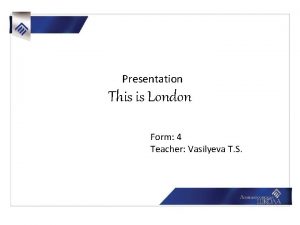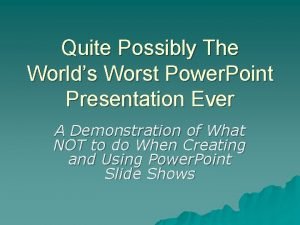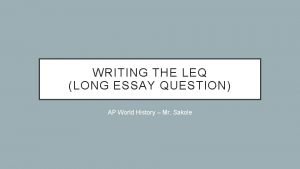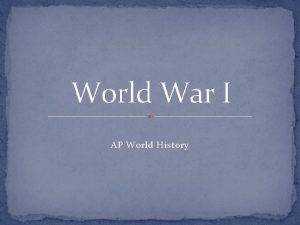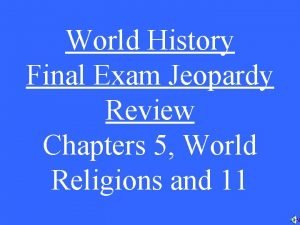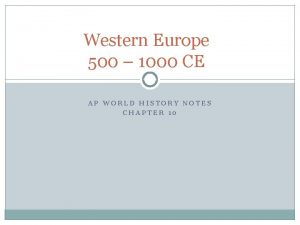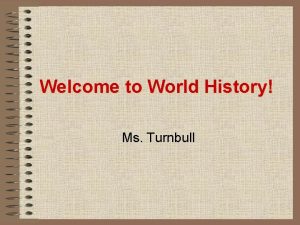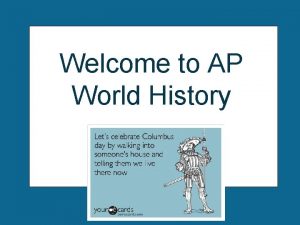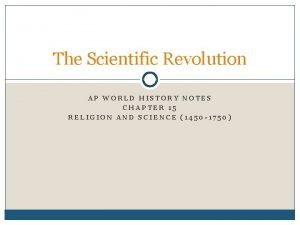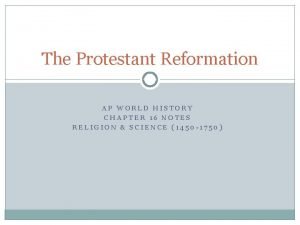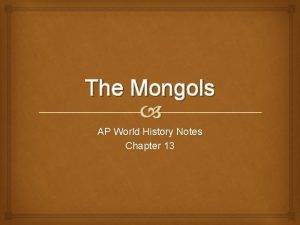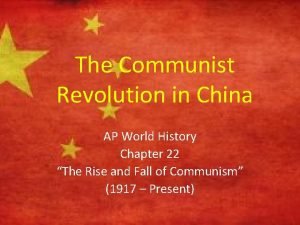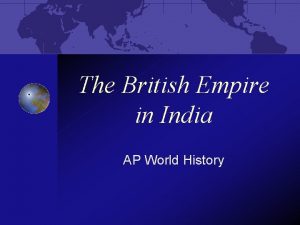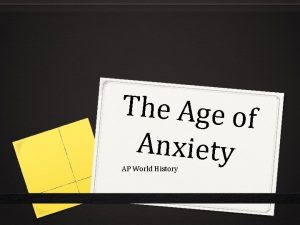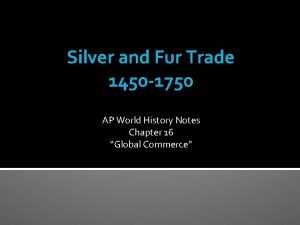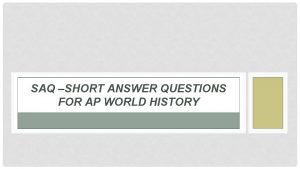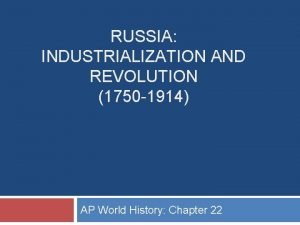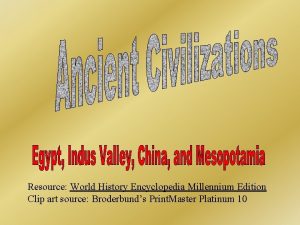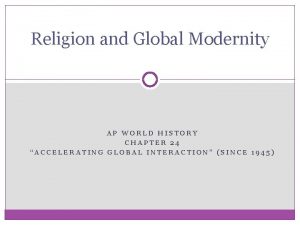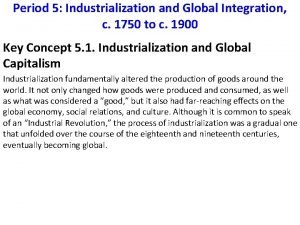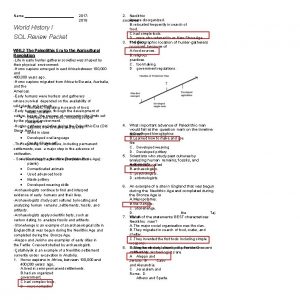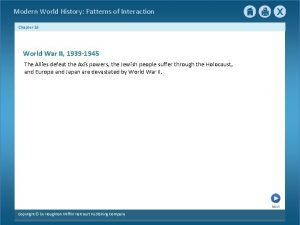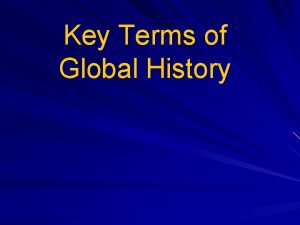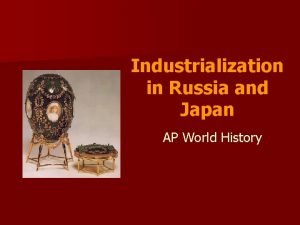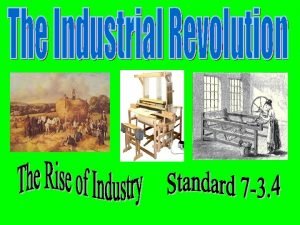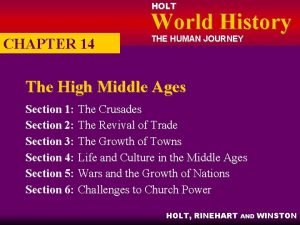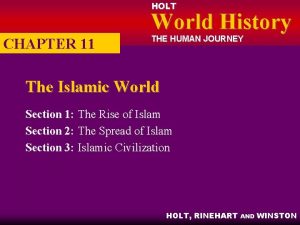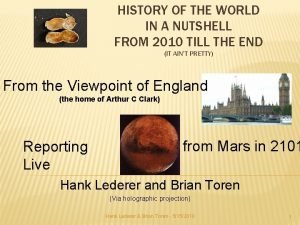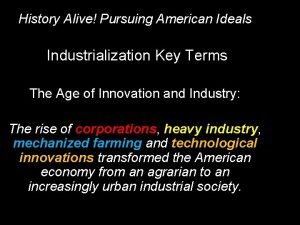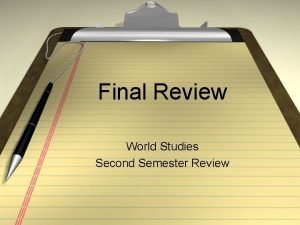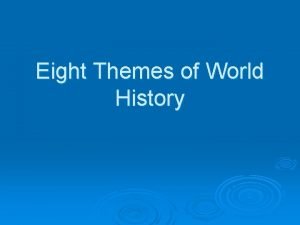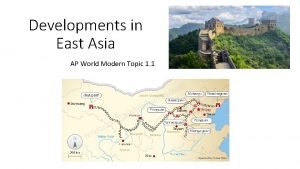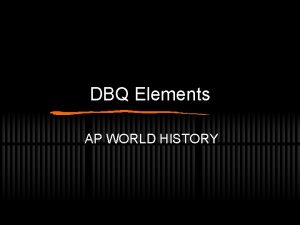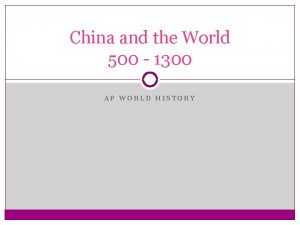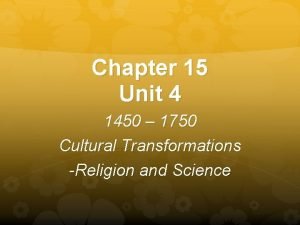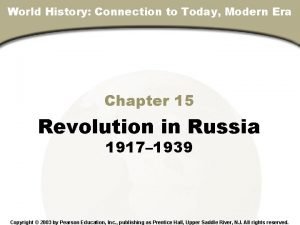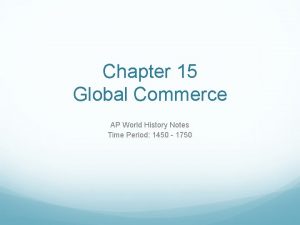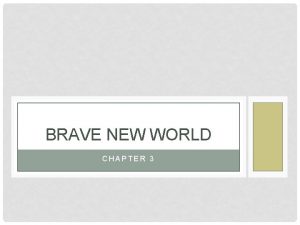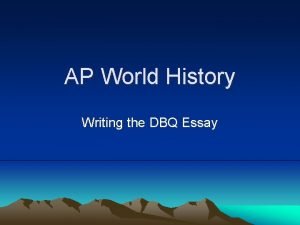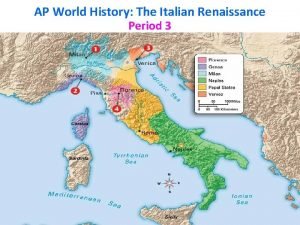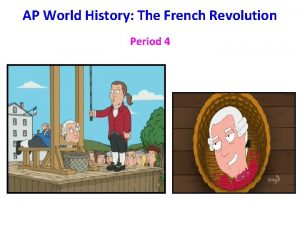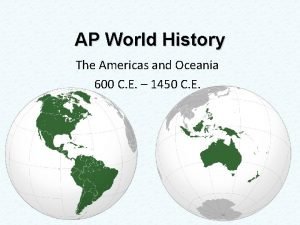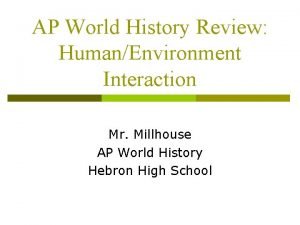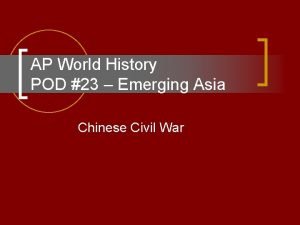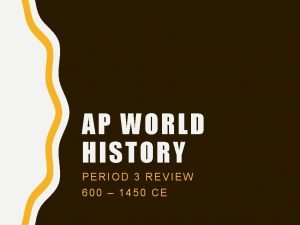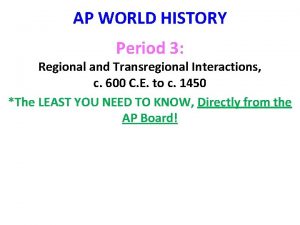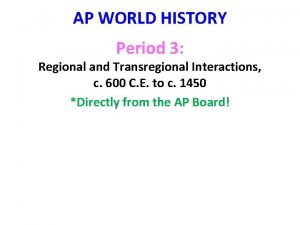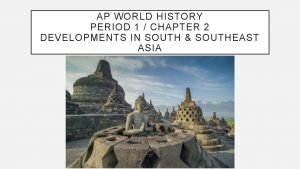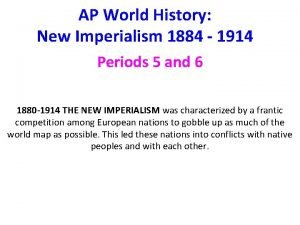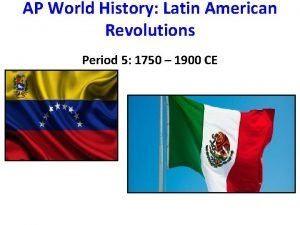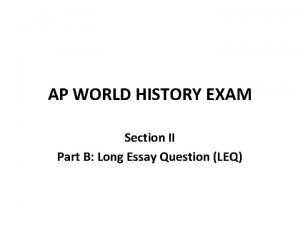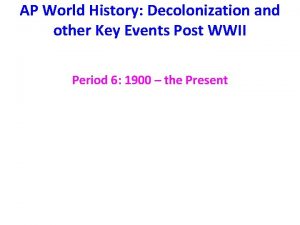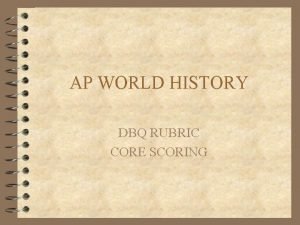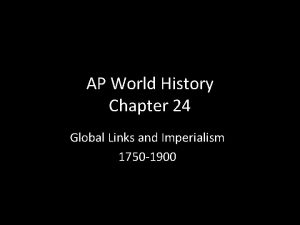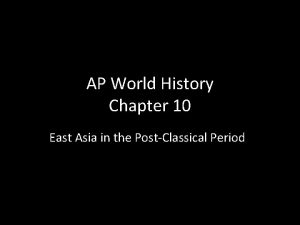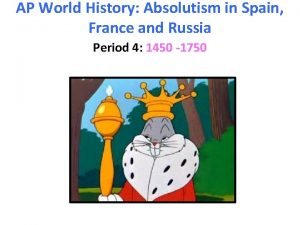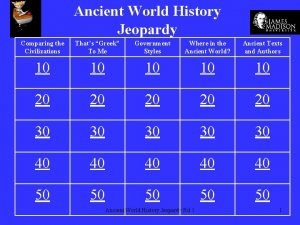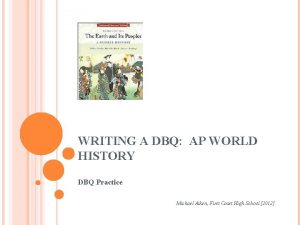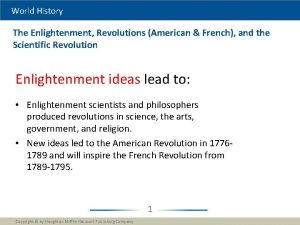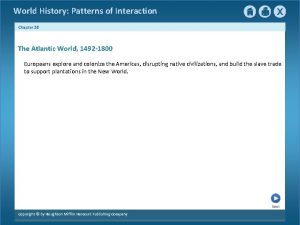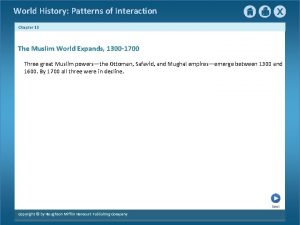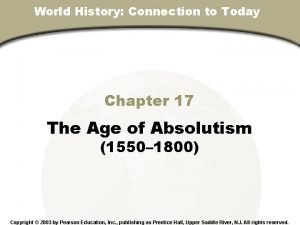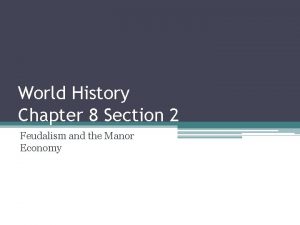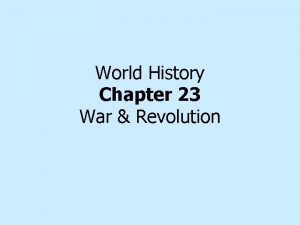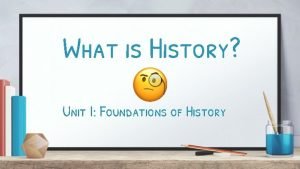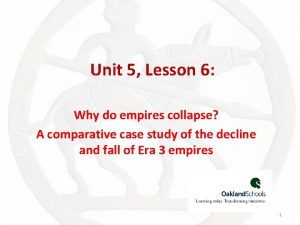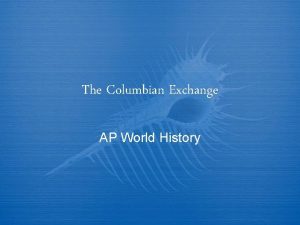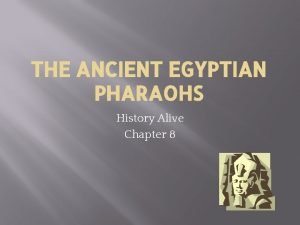Presentation Plus Glencoe World History Modern Times Copyright


















































































































































- Slides: 146

Presentation Plus! Glencoe World History: Modern Times Copyright © by The Mc. Graw-Hill Companies, Inc. Developed by FSCreations, Inc. , Cincinnati, Ohio 45202 Send all inquiries to: GLENCOE DIVISION Glencoe/Mc. Graw-Hill 8787 Orion Place Columbus, Ohio 43240


Chapter Introduction Section 1 General Trends in Latin America Section 2 Mexico, Cuba, and Central America Section 3 The Nations of South America Chapter Summary Chapter Assessment Click on a hyperlink to view the corresponding slides.

Click the Speaker button to listen to the audio again.

Key Events As you read this chapter, look for the key events in the history of Latin American nations. • Many Latin American nations have experienced severe economic problems, and their governments have been led by military dictators. • Successful Marxist revolutions in Cuba and Nicaragua fed fears in the United States about the spread of communism in the Americas. Click the mouse button or press the Space Bar to display the information.

The Impact Today The events that occurred during this time period still impact our lives today. • Latin American influence in the United States can be seen in art, music, literature, and foods. • Rapid and unplanned industrial development in some Latin American countries has led to heightened concern about the environment. Click the mouse button or press the Space Bar to display the information.

Chapter Objectives After studying this chapter, you should be able to: • list the economic and political changes that Latin America experienced after 1945. • describe the chief features and impact of the Cuban Revolution. • identify the major educational and cultural trends in Latin America since 1945. • understand that dictatorships were an oppressive consequence of political and economic instability. Click the mouse button or press the Space Bar to display the information.

Chapter Objectives After studying this chapter, you should be able to: • summarize how Latin American countries have become more democratic.


General Trends in Latin America Main Ideas • Exporting raw materials and importing manufactured goods has led to economic and political troubles for Latin American nations. • Many Latin American nations began to build democratic systems in the late 1980 s. Key Terms • multinational corporation • magic realism Click the mouse button or press the Space Bar to display the information.

General Trends in Latin America People to Identify • Gabriel García Márquez • Oscar Niemeyer Places to Locate • Chile • Peru • Brazil • Colombia • Bolivia Click the mouse button or press the Space Bar to display the information.

General Trends in Latin America Preview Questions • What factors undermined the stability of Latin American countries? • How did the roles of women change in Latin America after 1945? Click the mouse button or press the Space Bar to display the information.

General Trends in Latin America Preview of Events

Click the Speaker button to listen to the audio again.

The United States prevented Communist takeovers in Guatemala in 1954, Bolivia in 1956, and Chile in 1973.

Economic and Political Developments • After World War II, Latin American countries developed industries to produce goods that were formerly imported. • By the 1960 s, however, Latin American countries were dependent on the United States, Europe, and Japan for the advanced technology needed for modern industries. • Many Latin American countries could not find foreign markets for their goods. (pages 683– 685) Click the mouse button or press the Space Bar to display the information.

Economic and Political Developments (cont. ) • Economic failures in Latin American countries such as Chile, Brazil, and Argentina led to instability and reliance on military regimes. • Some regimes encouraged multinational corporations, or companies with divisions in more than two countries, to come to Latin America. • In the 1970 s, Latin American countries borrowed money to maintain their weak economies. (pages 683– 685) Click the mouse button or press the Space Bar to display the information.

Economic and Political Developments (cont. ) • By the 1980 s, the large debts owed to foreign countries caused many Latin American economies to fall apart. • To get new loans, Latin American countries were forced to make reforms. • The debt crisis in several Latin American countries led to the establishment of democratic regimes. (pages 683– 685) Click the mouse button or press the Space Bar to display the information.

Economic and Political Developments (cont. ) Why did the debt crisis of the 1980 s lead to the establishment of democratic regimes in Latin America? Some military leaders were unwilling to deal with the large debt problems. Many people realized that military power without popular consent could not maintain a strong state. (pages 683– 685) Click the mouse button or press the Space Bar to display the answer.

Latin American Society • Between 1950 and the mid-1980 s, the population of Latin America grew dramatically. • This caused a rapid rise in the number and size of cities by 2000. • Slums became part of many Latin American cities. • The gap between the rich and the poor in Latin America remained quite large. • Many Latin American women have found work outside the home. (page 686) Click the mouse button or press the Space Bar to display the information.

Latin American Society • The international drug trade has brought crime and corruption to some Latin American countries and undermined their stability. (page 686)

Latin American Society How has society in Latin American countries changed between 1950 and today? The population has grown dramatically. This has caused an increase in the number and size of cities in Latin America. Slums have become part of the cities. The gap between rich and poor remains very large. Women have found work outside the home. The international drug trade has brought crime and corruption to some Latin American countries and undermined their stability. (page 686) Click the mouse button or press the Space Bar to display the answer.

The United States and Latin America • In 1948, the states of the Western Hemisphere formed the Organization of American States (OAS), which called for an end to military action by one state in the affairs of any other state. • The United States continued to send troops and military aid to Latin American countries to protect U. S. interests and help friendly dictators and anti-Communist regimes. (page 686) Click the mouse button or press the Space Bar to display the information.

The United States and Latin America What was the purpose of the OAS? The OAS called for an end to military action by one state in the affairs of any other state. (page 686) Click the mouse button or press the Space Bar to display the answer.

Latin American Culture • Latin American writers and artists have been granted a high public status because they can express the hopes of the people. • In literature, Latin Americans developed a style called magic realism, a merging of realistic events with dreamlike or fantastic backgrounds. • The novel One Hundred Years of Solitude by Gabriel García Márquez is one of the foremost examples of a work written in this style. (page 687) Click the mouse button or press the Space Bar to display the information.

Latin American Culture (cont. ) • After World War II, Latin American art and architecture were strongly influenced by international styles. • Oscar Niemeyer is Latin America’s greatest modern architect. (page 687) Click the mouse button or press the Space Bar to display the information.

Latin American Culture (cont. ) Why have writers and artists played important roles in Latin American society? Latin American writers and artists have been granted a high public status because they can express the hopes of the people. (page 687) Click the mouse button or press the Space Bar to display the answer.

Checking for Understanding Define Match each definition in the left column with the appropriate term in the right column. __ 1. a company with divisions in A. multinational A more than two countries corporation __ 2. form of expression unique to B. magic realism B Latin American literature; it combines realistic events with dreamlike or fantastic backgrounds Click the mouse button or press the Space Bar to display the answers.

Checking for Understanding Explain how the Great Depression hurt Latin American economies. Have these economies recovered from the problems caused by the Great Depression? Exports fell, and revenues declined. Latin American countries developed industries to produce formerly imported goods. Click the mouse button or press the Space Bar to display the answer.

Checking for Understanding List two well-known Latin American writers. Why are writers and artists held in such high regard in Latin America? Gabriela Mistral and Gabriel García Márquez, like other artists and writers, express the hopes of the people. Click the mouse button or press the Space Bar to display the answer.

Critical Thinking Analyze Why did the rapid rate of population growth in many Latin American countries cause problems for their political and economic systems? Cities and slums grew rapidly, creating a gap between rich and poor. Peasants and the urban poor struggled to survive. These conditions strain economies and lead to political instability and repressive regimes. Click the mouse button or press the Space Bar to display the answer.

Analyzing Visuals Examine the photograph of a Latin American mother with her children shown on page 686 of your textbook. How does this photograph reflect the concerns faced by many Latin American women? It reflects poverty, unemployment, and the lack of opportunity. Click the mouse button or press the Space Bar to display the answer.

Close Write a one-page study guide summarizing the main themes of this section.


Mexico, Cuba, and Central America Main Ideas • Mexico and Central America faced political and economic crises after World War II. • The United States feared the spread of communism in Central American countries, which led to active American involvement in the region. Key Terms • privatization • contra • trade embargo Click the mouse button or press the Space Bar to display the information.

Mexico, Cuba, and Central America People to Identify • Vicente Fox • Manuel Noriega • Fidel Castro Places to Locate • Havana • Nicaragua • El Salvador • Panama Click the mouse button or press the Space Bar to display the information.

Mexico, Cuba, and Central America Preview Questions • What problems did Mexico and the nations of Central America face after 1945? • What were the chief features and impact of the Cuban Revolution? Click the mouse button or press the Space Bar to display the information.

Mexico, Cuba, and Central America Preview of Events

Click the Speaker button to listen to the audio again.

On December 31, 1999, the United States turned over control of the Panama Canal to Panama.

The Mexican Way • Since the Mexican Revolution at the beginning of the twentieth century, the official political party of Mexico was the Institutional Revolutionary Party (PRI). • At the end of the 1960 s, students began to protest Mexico’s one-party government system. (pages 688– 689) Click the mouse button or press the Space Bar to display the information.

The Mexican Way (cont. ) • In the late 1970 s, large new oil reserves were discovered in Mexico. • The government became dependent on oil revenues. • Oil prices dropped in the mid-1980 s, forcing the government to adopt new economic policies, such as privatization, or the sale of government-owned companies to private firms. (pages 688– 689) Click the mouse button or press the Space Bar to display the information.

The Mexican Way (cont. ) • The debt crisis and rising unemployment led to decreased support for the PRI. • In 2000, Vicente Fox defeated the PRI for the presidency. (pages 688– 689) Click the mouse button or press the Space Bar to display the information.

The Mexican Way (cont. ) Why did the PRI lose the presidency in Mexico in 2000? The debt crisis and rising unemployment led to decreased support for the PRI. (pages 688– 689) Click the mouse button or press the Space Bar to display the answer.

The Cuban Revolution • In the 1950 s, an opposition movement arose in Cuba. • Led by Fidel Castro, its aim was to overthrow dictator Fulgencio Batista. • Castro’s revolutionaries gained control of Havana in 1959. • Many Cubans who disagreed with Castro fled to the United States. (pages 689– 690) Click the mouse button or press the Space Bar to display the information.

The Cuban Revolution (cont. ) • Relations between the United States and Cuba quickly deteriorated as Castro began to receive aid from the Soviet Union and arms from Eastern Europe. • In October 1960, the United States declared a trade embargo prohibiting trade with Cuba. • In January 1961, the United States broke diplomatic relations with Cuba. (pages 689– 690) Click the mouse button or press the Space Bar to display the information.

The Cuban Revolution (cont. ) • In April 1961, U. S. president John F. Kennedy supported an attempt to overthrow Castro’s government. • The attempt failed. • The Soviets then placed missiles in Cuba, leading to the Cuban missile crisis. (pages 689– 690) Click the mouse button or press the Space Bar to display the information.

The Cuban Revolution (cont. ) • The Cuban economy relied on Soviet aid and the purchase of Cuban sugar by Soviet bloc countries. • When the Soviet Union collapsed, Cuba lost its support. • Cuba’s economy has continued to decline. (pages 689– 690) Click the mouse button or press the Space Bar to display the information.

The Cuban Revolution (cont. ) Why did Cuba’s economy rely on the Soviet Union? Relations between the United States and Cuba quickly deteriorated as Castro began to receive aid from the Soviet Union and arms from Eastern Europe. In October 1960, the United States declared a trade embargo prohibiting trade with Cuba. (pages 689– 690) Click the mouse button or press the Space Bar to display the answer.

Upheaval in Central America • The economies of Central American countries rely on the export of bananas, coffee, and cotton. • Prices for these goods have varied over time, causing economic crises. • The gap between the rich and the poor in Central America causes instability. • The fear of the spread of communism in the region caused the United States to support repressive regimes. (pages 690– 691) Click the mouse button or press the Space Bar to display the information.

Upheaval in Central America (cont. ) • In the late 1970 s and 1980 s, El Salvador had a bitter civil war. • During Ronald Reagan’s presidency, the United States gave military aid to the Salvadoran army to defeat the Marxist-led guerrillas. • Finally, in 1992, a peace settlement ended the war. (pages 690– 691) Click the mouse button or press the Space Bar to display the information.

Upheaval in Central America (cont. ) • In 1937, the Somoza family gained and kept control of Nicaragua until 1979. • The United States supported this repressive regime. • In 1979, the United States refused to support the regime any longer. • Marxist guerrilla forces, known as Sandinistas, gained control of Nicaragua. • The contras, a group opposed to the Sandinistas, tried to overthrow the government. (pages 690– 691) Click the mouse button or press the Space Bar to display the information.

Upheaval in Central America (cont. ) • The Reagan and Bush administrations supported the contras. • In 1990, the Sandinistas agreed to free elections. (pages 690– 691) Click the mouse button or press the Space Bar to display the information.

Upheaval in Central America (cont. ) • In 1903, the United States helped Panama gain independence from Colombia. • In return, the United States was able to build the Panama Canal and gained great influence over the government and economy of Panama. • After 1968, military leaders controlled power in Panama. (pages 690– 691) Click the mouse button or press the Space Bar to display the information.

Upheaval in Central America (cont. ) • In 1989, the United States sent troops to Panama to arrest its military leader, Manuel Noriega, who was later sent to prison in the United States for drug trafficking. • In 1999, the Panama Canal was turned over to Panama as outlined in a 1977 treaty. (pages 690– 691) Click the mouse button or press the Space Bar to display the information.

Upheaval in Central America (cont. ) What problems have faced Central American countries since the end of World War II? Prices for the region’s main exports have varied over time, creating economic crises. The large difference between the rich and the poor has created a climate of instability. Fear of the spread of communism often led the United States to support repressive regimes in the area. Some countries have experienced civil wars and problems related to drug trafficking. (pages 690– 691) Click the mouse button or press the Space Bar to display the answer.

Checking for Understanding Define Match each definition in the left column with the appropriate term in the right column. __ 1. rebels financed by the United A. privatization C States who began a guerrilla B. trade embargo war against the Sandinista C. contras government in Nicaragua __ 2. the sale of government. A owned companies to private firms __ 3. a policy prohibiting trade with B a particular country Click the mouse button or press the Space Bar to display the answers.

Checking for Understanding Explain why the Cubans attempted to spur revolution in the rest of Latin America. The Cubans wanted to keep the revolutionary movement in Cuba alive. Click the mouse button or press the Space Bar to display the answer.

Checking for Understanding List the political reforms enacted by Mexican presidents Luís Echeverría and José López Portillo. They allowed greater freedom of debate in the press and universities, and they opened the door to participation by new political parties. Click the mouse button or press the Space Bar to display the answer.

Critical Thinking Evaluate Why did relations between the Soviet Union and Cuba become more difficult after 1962? The Soviet Union had backed down in the 1962 Cuban missile crisis, leading Castro to realize that the Soviet Union was unreliable. Click the mouse button or press the Space Bar to display the answer.

Analyzing Visuals Examine the photo of Castro on page 682 and the photo of a Cuban refugee on page 689 of your textbook. What inferences can you draw about Castro’s reign in Cuba from looking at these photos? It was a military-based, poor nation. The number of refugees implies that many disliked Castro’s rule. Click the mouse button or press the Space Bar to display the answer.

Close Summarize the ways in which the United States has intervened in Central America and Cuba. Evaluate the consequences of U. S. involvement in these countries.


The Nations of South America Main Ideas • South American nations have experienced economic, social, and political problems. • Democracy has advanced in South America since the late 1980 s. Key Terms • cooperative • Shining Path Click the mouse button or press the Space Bar to display the information.

The Nations of South America People to Identify • Juan Perón • Augusto Pinochet • Salvador Allende • Juan Velasco Alvarado Places to Locate • Argentina • Falkland Islands Click the mouse button or press the Space Bar to display the information.

The Nations of South America Preview Questions • What obstacles does the new democratic government in Brazil face? • What factors have been the greatest causes of South American instability? Click the mouse button or press the Space Bar to display the information.

The Nations of South America Preview of Events

Click the Speaker button to listen to the audio again.

Brazil is the largest country in South America in area and in population. About three-fourths of Brazil’s population lives in urban areas. Brasília, Brazil’s capital, is an example of large-scale city planning. Brazilians wanted their capital to be located inland to help settle the country’s undeveloped interior. Construction of Brasília began in 1956. In 1960, Brazil’s capital moved from the coastal city of Rio de Janeiro to Brasília.

Argentina • For years, Argentina was ruled by a powerful oligarchy. • In 1943, a group of military officers overthrew the oligarchy. • Juan Perón used his position as labor secretary in the military government to win over the working class. • He encouraged them to join labor unions, and he increased job benefits. (pages 693– 694) Click the mouse button or press the Space Bar to display the information.

Argentina (cont. ) • Juan Perón was elected president of Argentina in 1946. • To please his main supporters– labor and the working middle class–Perón increased industrialization. • He worked to rid Argentina of foreign investors. • His regime was authoritarian. (pages 693– 694) Click the mouse button or press the Space Bar to display the information.

Argentina (cont. ) • Perón died in 1974. • A new military regime took power in 1976. • To divert people’s attention from economic problems, the regime invaded the Falkland Islands but was defeated by Great Britain. (pages 693– 694) Click the mouse button or press the Space Bar to display the information.

Argentina (cont. ) • In 1983, Raúl Alfonsín was elected president of Argentina and worked to restore democratic practices. • In 1989, Carlos Saúl Menem won the presidential election. • The peaceful transfer of power gave rise to hope for democracy in Argentina. (pages 693– 694) Click the mouse button or press the Space Bar to display the information.

Argentina (cont. ) How did Juan Perón win over the working class of Argentina? He encouraged them to join labor unions, increased job benefits and industrialization, and worked to rid Argentina of foreign investors. (pages 693– 694) Click the mouse button or press the Space Bar to display the answer.

Brazil • After World War II, Brazil’s democratically elected governments were unable to solve the country’s severe economic problems. • In 1964, the military seized control of Brazil. • The military reduced government interference in the economy and stressed free market forces. • Brazil’s economy grew dramatically. (pages 694– 695) Click the mouse button or press the Space Bar to display the information.

Brazil (cont. ) • The gap between the rich and the poor of Brazil widened. • The inflation rate grew to 100 percent a year. • The military regime was replaced by a return to democracy in 1985. • A massive foreign debt, severe inflation, and a lack of social unity faced the new democratic government. • In the 1990 s, a series of democratically elected presidents led to some stability in Brazil’s economy. (pages 694– 695) Click the mouse button or press the Space Bar to display the information.

Brazil (cont. ) What problems have Brazil’s governments faced since World War II? After World War II, Brazil’s democratically elected governments were unable to solve the country’s severe economic problems. In 1964, the military seized control of Brazil. The military reduced government interference in the economy and stressed free-market forces. Brazil’s economy grew dramatically. The gap between the rich and the poor of Brazil widened. The inflation rate grew to 100 percent a year. The military regime was replaced by a return to democracy in 1985. A massive foreign debt, severe inflation, and a lack of social unity faced the new democratic government. (pages 694– 695) Click the mouse button or press the Space Bar to display the answer.

Chile • In 1970, Marxist Salvador Allende was elected president of Chile. • He increased the wages of industrial workers and nationalized the largest domestic and foreign-owned corporations. • Nationalization of the copper industry angered American owners of the copper companies and the American government. (page 695) Click the mouse button or press the Space Bar to display the information.

Chile (cont. ) • In 1973, fearful of Allende’s growing support, the Chilean army led by General Augusto Pinochet overthrew Allende’s government. • The military set up a dictatorship with Pinochet as its leader. • Pinochet’s government was one of the most brutal in Chile’s history. • In 1989, free elections led to the defeat of Pinochet and to a more democratic system. (page 695) Click the mouse button or press the Space Bar to display the information.

Chile (cont. ) What was the Pinochet regime like? It was one of the most brutal regimes in Chile’s history. Thousands of opponents were imprisoned. Thousands more were tortured and murdered. Political parties were outlawed. Pinochet did away with the congress. (page 695) Click the mouse button or press the Space Bar to display the answer.

Peru • The history of Peru’s government is one of instability. • The economy has a history of extreme ups and downs. • In 1968, General Juan Velasco Alvarado took over Peru’s government. • He seized about 75 percent of the nation’s large landed estates and put ownership of the land into the hands of peasant cooperatives–farm organizations owned by and operated for the peasants’ benefits. (pages 695– 696) Click the mouse button or press the Space Bar to display the information.

Peru (cont. ) • In 1975, Peruvian military leaders removed Alvarado from power. • In 1980, the military returned Peru to civilian rule. • The new government had problems with the Shining Path, a group of radical guerrillas with ties to Communist China who killed missionaries, mayors, priests, and peasants. • They wanted to rid Peru of all authority and create a classless society. (pages 695– 696) Click the mouse button or press the Space Bar to display the information.

Peru (cont. ) • In June 2001, Alejandro Toledo became Peru’s first freely elected president of Native American descent. (pages 695– 696)

Peru (cont. ) What is the history of Peru’s government and economy? The history of Peru’s government is one of instability. The economy has a history of extreme ups and downs. (pages 695– 696) Click the mouse button or press the Space Bar to display the answer.

Colombia • A conservative elite led by the owners of coffee plantations has dominated Colombia’s democratic political system. • After World War II, Marxist guerrilla groups began to organize Colombian peasants. • The government killed more than two hundred thousand peasants by the mid 1960 s. • Violence continued through the 1980 s and 1990 s. (page 696) Click the mouse button or press the Space Bar to display the information.

Colombia (cont. ) • Poor peasants turned to coca leaves, used to make cocaine, as a cash crop. • The drug trade increased under powerful cartels. • The United States and Colombian governments have waged an aggressive war on drugs, which included deployment of U. S. troops to Colombia in 2003. (page 696) Click the mouse button or press the Space Bar to display the information.

Colombia (cont. ) Why does the drug trade thrive in Colombia? Poor peasants turned to coca leaves, used to make cocaine, as a cash crop. The drug trade and drug lords increased. Drug lords formed cartels that used bribes and violence to force government cooperation in the drug traffic. (page 696) Click the mouse button or press the Space Bar to display the answer.

Checking for Understanding Define Match each definition in the left column with the appropriate term in the right column. __ 1. a radical guerrilla group in A. cooperative B Peru with ties to Communist B. Shining Path China __ 2. a farm organization owned A by and operated for the benefit of the farmers Click the mouse button or press the Space Bar to display the answers.

Checking for Understanding Explain why the Argentine military invaded the Falkland Islands. What was the impact of this invasion on the government of Argentina? The Argentine military invaded the Falkland Islands to divert attention from economic problems. The result was a defeat which discredited the military and opened the door to civilian rule. Click the mouse button or press the Space Bar to display the answer.

Checking for Understanding List the obstacles Brazil’s new democratic government faced in 1985. How did economic conditions help this democratic government come to power? Massive foreign debt, increasingly severe inflation, and a lack of social unity were all obstacles the new government faced. Economic problems overwhelmed the military regime. Click the mouse button or press the Space Bar to display the answer.

Critical Thinking Analyze Why is it often easier for the military to seize power in a nation than it is for the military to rule that nation effectively? Which countries discussed in this chapter seem to support this theory? Military regimes are usually repressive, leading to popular unrest. Click the mouse button or press the Space Bar to display the answer.

Analyzing Visuals Examine the photograph of a Brazilian city shown on page 693 of your textbook. How does this photograph reflect the problems created by the Brazilian “economic miracle”? It increased the gulf between rich and poor. Click the mouse button or press the Space Bar to display the answer.

Close List the challenges facing the countries of South America today.


Chapter Summary Several Latin American countries have moved from conflict to cooperation.


Using Key Terms Insert the key term that best completes each of the following sentences. 1. The anti-Communist forces that fought the Sandinistas in Nicaragua were called _______. contras 2. A style of literature that combines elements of the real magic realism world with imaginary events is called _______. 3. Selling government-owned companies to individuals or privatization to corporations is called _______. 4. The refusal to import or export goods to or from another trade embargo country is a _______. 5. The Communist guerrilla movement in Peru is called Shining Path the _______. Click the mouse button or press the Space Bar to display the answers.

Reviewing Key Facts History What is the purpose of the Organization of American States? The OAS aims to end military action by one state in the affairs of another state in the Western Hemisphere. Click the mouse button or press the Space Bar to display the answer.

Reviewing Key Facts Economics What did Fidel Castro do in 1960 that probably contributed to the decision of the United States to sponsor an invasion of Cuba at the Bay of Pigs in 1961? Castro began to receive aid from the Soviet Union and arms from Eastern Europe. Click the mouse button or press the Space Bar to display the answer.

Reviewing Key Facts Culture Who is considered the most famous of the Latin American novelists? Gabriel García Márquez is considered the most famous of the Latin American novelists. Click the mouse button or press the Space Bar to display the answer.

Reviewing Key Facts History What happened that ended Manuel Noriega’s control of Panama in 1989? The U. S. military invaded Panama and arrested him. He was sent to prison on charges of drug trafficking. Click the mouse button or press the Space Bar to display the answer.

Reviewing Key Facts Government What was the goal of the guerrilla group known as Shining Path? The Shining Path’s goal was to smash all authority and create a classless society. Click the mouse button or press the Space Bar to display the answer.

Critical Thinking Compare and Contrast Compare the policies of the United States toward Latin American countries to those of the Soviet Union toward countries in Eastern Europe. Soviet control of Eastern European nations was much more comprehensive than the influence the United States has exerted on Latin American nations. The United States has generally avoided direct military intervention in Latin American nations. Instead, it has funded anti-Communist governments and guerrilla movements. Click the mouse button or press the Space Bar to display the answer.

Critical Thinking Drawing Inferences Analyze why the United States used its military power to arrest Manuel Noriega after ignoring many other dishonest and corrupt leaders in Latin America.

Analyzing Maps and Charts Study the map below and answer the questions on the following slides.

Analyzing Maps and Charts Which South American country has the largest geographic area? Which countries have the largest populations? Brazil has the largest geographic area. Brazil and Mexico have the largest populations. Click the mouse button or press the Space Bar to display the answer.

Analyzing Maps and Charts How do the populations of Central American countries compare to the populations of other Latin American countries? They have less population due to smaller areas. Click the mouse button or press the Space Bar to display the answer.

Analyzing Maps and Charts Which South American countries are landlocked? Between what degrees of latitude and longitude are they located? Bolivia and Paraguay are landlocked. Both are located between 10º and 30ºs latitude and between 70º and 55ºw longitude. Click the mouse button or press the Space Bar to display the answer.

Standardized Test Practice Directions: Choose the best answer to the following question. Why are Latin American countries economically important to the United States? A American banks need countries such as Brazil and Mexico to default on their loans. B Latin American countries are popular destinations for American tourists. C Latin American countries are colonies of European nations. D America imports raw goods such as oil, coffee, and copper from Mexico, El Salvador, Colombia, and Chile. Test-Taking Tip Read test questions carefully because every word is important. This question asks why Latin America is economically important. Therefore, you can eliminate any answer choices that do not offer explanations about their economic importance. Click the mouse button or press the Space Bar to display the answer.

Which of the three regional groupings in this chapter–Mexico and the Caribbean, Central America, or South America–do you think has the best prospects for the future?


Explore online information about the topics introduced in this chapter. Click on the Connect button to launch your browser and go to the Glencoe World History: Modern Times Web site. At this site, you will find interactive activities, current events information, and Web sites correlated with the chapters and units in the textbook. When you finish exploring, exit the browser program to return to this presentation. If you experience difficulty connecting to the Web site, manually launch your Web browser and go to http: //wh. mt. glencoe. com

Economics Population Click on a hyperlink to view the corresponding slide.

Economics Discuss why democracy is in a precarious position in any state that is experiencing economic instability. Bolivia had an annual inflation rate that reached 24, 000 percent in the 1980 s. What did that inflation rate do to the price of gas and utilities? Compute the price changes using the prices of items with which you are familiar.

Population According to the U. S. Census of 2000, Hispanics are the majority ethnic group in the United States. Determine the effect of immigration in your local area. Perhaps you live in an area of Asian immigration. Try to understand why people emigrate.

Archbishop Oscar Romero In the 1970 s and 1980 s, El Salvador was torn by civil war. Oscar Romero was appointed archbishop because he was seen as a moderate figure. Shortly after his appointment, his friend Father Rutillo Grande was assassinated by a paramilitary death squad. This changed Romero from a moderate to an activist, speaking out openly against government-sponsored death squads. He was nominated for the Nobel Peace Prize for his courageous efforts. In 1980, as Romero was preparing mass, a shot rang out from the back of the church. Romero was killed instantly.

Bay of Pigs About 1, 500 anti-Castro exiles, trained by the Unite States, landed in Cuba at the Bay of Pigs. They wanted Cubans to revolt against Castro. The anti-Castro exiles were hoping for American military support, but President Kennedy barred open military support. The Cuban people did not join the anti-Castro invasion and most of the invaders were captured or killed. The invasion tarnished Kennedy’s presidency and damaged the image of the United States.

Developing a Database Why Learn This Skill? Do you have an address book with your friends' names; addresses; and phone, fax, pager, and cell numbers? Do you have to cross out information when numbers change? When you have a party, do you address all the invitations by hand? If your address book were stored in a computer, you could find a name instantly. You could update your address book easily and use the computer to print out invitations and envelopes. This feature can be found on page 697 of your textbook.

Developing a Database Why Learn This Skill? (cont. ) When you collect information in a computer file, the file is called an electronic database. The database can contain any kind of information: lists detailing your CD collection; notes for a research paper; your daily expenses. Using an electronic database can help you locate information quickly and organize and manage it, no matter how large the file. This feature can be found on page 697 of your textbook.

Developing a Database Learning the Skill An electronic database is a collection of facts that is stored in a file on the computer. Although you can build your own database, there is special software–called a database management system (DBMS)–that makes it easy to add, delete, change, or update information. Some popular commercial DBMS programs allow you to create address books, note cards, financial reports, family trees, and many other types of records. A database can be organized and reorganized in any way that is useful to you. This feature can be found on page 697 of your textbook. Click the mouse button or press the Space Bar to display the information.

Developing a Database Learning the Skill (cont. ) • The DBMS software program will usually give clear instructions about entering and arranging your information. • The information in a database is organized into different fields. For example, in an address book, one field might be your friends’ names and another could be their addresses. • When you retrieve information, the computer will search through the files and display the information on the screen. Often it can be organized and displayed in a variety of ways, depending on what you want. This feature can be found on page 697 of your textbook. Click the mouse button or press the Space Bar to display the information.

Developing a Database Practicing the Skill Fidel Castro is one of the Latin American leaders discussed in this chapter. Use the following steps to build a database of the political events that have taken place during his years as Cuba’s leader. This feature can be found on page 697 of your textbook.

Developing a Database Practicing the Skill (cont. ) 1. Determine what facts you want to include in your database. 2. Follow the instructions in the DBMS that you are using to set up fields. 3. Determine how you want to organize the facts in the database–chronologically by the date of the event, or alphabetically by the name of the event. 4. Follow the instructions in your computer program to place the information in order of importance. This feature can be found on page 697 of your textbook. Click the mouse button or press the Space Bar to display the information.

A victorious Fidel Castro rides through the streets of Havanna in 1959 Read The Castro Brothers on page 682 of your textbook. Then answer the questions on the following slides. This feature can be found on page 682 of your textbook.

How successful was the attack on Moncada? Most troops were killed, wounded, or arrested. This feature can be found on page 682 of your textbook. Click the mouse button or press the Space Bar to display the answer.

From today’s vantage point, how would you evaluate Batista’s decision to release the Castro brothers? Releasing them resulted in Batista’s overthrow. This feature can be found on page 682 of your textbook. Click the mouse button or press the Space Bar to display the answer.

What do you think will happen in Cuba when Castro is no longer the leader? This feature can be found on page 682 of your textbook.

Click the image on the right to listen to an excerpt from page 692 of your textbook. Read the information on page 692 of your textbook. Then answer the questions on the following slides. This feature can be found on page 692 of your textbook. Click the Speaker button to listen to the audio again.

What was the reason for the military attack on the students? The official government reports said that the Mexican authorities had been fired upon, and they returned the gunfire. This feature can be found on page 692 of your textbook. Click the mouse button or press the Space Bar to display the answer.

Why do you think the government reacted with such violence? Possible answer: It was only days before the opening of the Mexico City Olympics, and the Mexican government wanted to avoid the possibility of any disturbances during the Olympic Games. This feature can be found on page 692 of your textbook. Click the mouse button or press the Space Bar to display the answer.

Do you think the government handled the situation well? Why or why not? This feature can be found on page 692 of your textbook.

The Cuban Revolution Objectives After viewing “The Cuban Revolution, ” you should: • Realize that the brutal and corrupt rule of the Batista regime opened the door for Fidel Castro to gain support for a revolt in 1959. • Know that Cubans have had few rights and freedoms under Castro's rule and that Cuba has suffered economically as well. • Reflect on the reasons for ongoing tensions in U. S. -Cuban relations. Click the mouse button or press the Space Bar to display the information. Click in the window above to view a preview of The World History–Modern Times video.

The Cuban Revolution What was life like in Cuba under the Batista regime? Corruption was widespread, poverty was rampant, and political dissent was stifled. Click the mouse button or press the Space Bar to display the answer.

The Cuban Revolution Why have Cubans called Castro both a hero and a devil? Many people have considered Castro a hero because he led a popular revolt. However, many people have considered him evil because he stifled political liberties. Click the mouse button or press the Space Bar to display the answer.


Maps Major Developments in Latin America Since 1945 Per Capita Income, 1960 s Main Exports, 1990 s Chart Population of Latin America, 1950– 2020 Click on a hyperlink to view the corresponding slide.






a slum area with high-rise apartments or hotels in the background Possible answer: They are planning to build a shanty or hut with them. There are extremes of wealth and poverty. Click the mouse button or press the Space Bar to display the answers.

They disagreed with Castro. It drove them closer together. Click the mouse button or press the Space Bar to display the answers. It was heavily dependent on aid from the Soviet Union.

It is the inauguration of Brazil’s president. Brazil will be transformed into a sovereign, dignified nation. Click the mouse button or press the Space Bar to display the answers. The president refers to treating all citizens with justice and compassion.

End of Custom Shows WARNING! Do Not Remove This slide is intentionally blank and is set to auto-advance to end custom shows and return to the main presentation.

 Lower outlier boundary calculator
Lower outlier boundary calculator Mat0022
Mat0022 Ocr gcse modern world history revision guide
Ocr gcse modern world history revision guide Ap world history chapter 25 africa and the atlantic world
Ap world history chapter 25 africa and the atlantic world Dangerous world tour history world tour - hockenheimring
Dangerous world tour history world tour - hockenheimring Charlie chaplin industrial revolution
Charlie chaplin industrial revolution Presentation copyright disclaimer
Presentation copyright disclaimer Presentation copyright disclaimer
Presentation copyright disclaimer Plus haut plus loin que l'azur infini
Plus haut plus loin que l'azur infini Je contiens du sucre sans être sucré que suis-je
Je contiens du sucre sans être sucré que suis-je Kambr ordowik
Kambr ordowik Plus j'apprends plus je me rends compte de mon ignorance
Plus j'apprends plus je me rends compte de mon ignorance Glencoe accounting chapter 14 answer key
Glencoe accounting chapter 14 answer key Glencoe accounting chapter 12
Glencoe accounting chapter 12 Physics chapter 2 review
Physics chapter 2 review Glencoe health chapter 2
Glencoe health chapter 2 Glencoe sustainability task force
Glencoe sustainability task force Texture repair glencoe
Texture repair glencoe Chapter 19 vocabulary glencoe health
Chapter 19 vocabulary glencoe health Glencoe health chapter 7
Glencoe health chapter 7 Glencoe health chapter 5
Glencoe health chapter 5 Glencoe health chapter 5
Glencoe health chapter 5 Chapter 5 glencoe health
Chapter 5 glencoe health Glencoe health chapter 5
Glencoe health chapter 5 Chapter 6 glencoe health
Chapter 6 glencoe health Chapter 12 lesson 1 benefits of physical activity
Chapter 12 lesson 1 benefits of physical activity Glencoe health chapter 12
Glencoe health chapter 12 Chapter 3 mental and emotional health
Chapter 3 mental and emotional health Glencoe the developing child
Glencoe the developing child Periodic table glencoe
Periodic table glencoe Glencoe personal finance
Glencoe personal finance Glencoe health chapter 2 review answers
Glencoe health chapter 2 review answers Glencoe exploring careers
Glencoe exploring careers 1-5 angle relationships
1-5 angle relationships Chapter 1 lesson 4 promoting health and wellness
Chapter 1 lesson 4 promoting health and wellness Glencoe exploring careers
Glencoe exploring careers Glencoe business and personal finance
Glencoe business and personal finance Chapter 1 understanding health and wellness lesson 2
Chapter 1 understanding health and wellness lesson 2 Chapter one understanding health and wellness
Chapter one understanding health and wellness Modern buffet presentation
Modern buffet presentation Modern hawaiian history
Modern hawaiian history Brief history of modern dance
Brief history of modern dance Floral design renaissance period
Floral design renaissance period Renaissance floral design history
Renaissance floral design history Byzantine floral history
Byzantine floral history Distinguish between fisher and cambridge equation
Distinguish between fisher and cambridge equation Modern history
Modern history History of modern portfolio theory
History of modern portfolio theory History of modern medicine in ethiopia
History of modern medicine in ethiopia 5cm labor
5cm labor Fundal height transverse lie
Fundal height transverse lie Challenges of being a disciple in the modern world
Challenges of being a disciple in the modern world Print culture and the modern world
Print culture and the modern world What is language in mathematics in the modern world
What is language in mathematics in the modern world Mythology in the modern world
Mythology in the modern world @en123
@en123 Print culture and the modern world
Print culture and the modern world Animus and anima definition
Animus and anima definition Making of the modern world warwick
Making of the modern world warwick Modern world
Modern world Tower of london presentation
Tower of london presentation Best and worst powerpoint presentations
Best and worst powerpoint presentations History also history physical
History also history physical Leq structure
Leq structure Total war world history definition
Total war world history definition Chapter 17 section 3 world history
Chapter 17 section 3 world history World history spring final exam review answers
World history spring final exam review answers Ap world history jeopardy
Ap world history jeopardy Chapter 32 assessment world history
Chapter 32 assessment world history Chapter 30 section 2 world history
Chapter 30 section 2 world history What was the counter-reformation?
What was the counter-reformation? World history final exam study guide
World history final exam study guide Manorial system ap world history
Manorial system ap world history Msturnbull world history
Msturnbull world history Prince henry the navigator ap world history
Prince henry the navigator ap world history Scientific revolution ap world history
Scientific revolution ap world history Chapter 16 lesson 1 the protestant reformation
Chapter 16 lesson 1 the protestant reformation Pastoralism ap world history
Pastoralism ap world history Globalization definition ap world history
Globalization definition ap world history Chinese communist party ap world history
Chinese communist party ap world history Chinese communist party ap world history
Chinese communist party ap world history British raj definition ap world history
British raj definition ap world history Dawes plan
Dawes plan Fur trade ap world history
Fur trade ap world history History saq
History saq Industrialization definition ap world history
Industrialization definition ap world history Art history encyclopedia
Art history encyclopedia Religious fundamentalism ap world history
Religious fundamentalism ap world history Zionist movement definition ap world history
Zionist movement definition ap world history World history 1 sol review packet
World history 1 sol review packet World history patterns of interaction
World history patterns of interaction Chapter 15 section 3 fascism rises in europe
Chapter 15 section 3 fascism rises in europe Nomad history definition
Nomad history definition World history jeopardy
World history jeopardy Samurai ap world history definition
Samurai ap world history definition Industrialism definition world history
Industrialism definition world history Holt world history the human journey
Holt world history the human journey Holt world history the human journey
Holt world history the human journey History of the world in a nutshell
History of the world in a nutshell Laissez faire definition world history
Laissez faire definition world history World history semester 2 final review packet
World history semester 2 final review packet World history fall semester exam review
World history fall semester exam review Five themes of world history
Five themes of world history Champa rice
Champa rice Dbq essay example ap world history
Dbq essay example ap world history 1300 + 500
1300 + 500 Ursula de jesus ap world history
Ursula de jesus ap world history Chapter 15 world history
Chapter 15 world history Ap world history chapter 15 notes
Ap world history chapter 15 notes Sinification ap world history
Sinification ap world history Brave new world history is bunk
Brave new world history is bunk How to write a thesis statement for a dbq
How to write a thesis statement for a dbq Thesis
Thesis Pieta period
Pieta period Robespierre ap world history
Robespierre ap world history Oceania ap world history
Oceania ap world history Champa rice ap world history
Champa rice ap world history Jiang jeishi
Jiang jeishi Ap world history period 3
Ap world history period 3 Caranversai
Caranversai Banking houses ap world history
Banking houses ap world history Sinhala dynasties ap world
Sinhala dynasties ap world New imperialism ap world history
New imperialism ap world history Napoleon ap world history
Napoleon ap world history Francisco madero definition ap world history
Francisco madero definition ap world history Apwh final exam review
Apwh final exam review Leq format
Leq format Decolonization ap world history
Decolonization ap world history Dbq rubric ap world
Dbq rubric ap world Ap world history course and exam description
Ap world history course and exam description Settler colonies ap world history
Settler colonies ap world history Scholar gentry definition ap world history
Scholar gentry definition ap world history St basil's cathedral ap world history
St basil's cathedral ap world history World history jeopardy
World history jeopardy Soapstone ap world history
Soapstone ap world history Practice dbq ap world
Practice dbq ap world Militarism world history definition
Militarism world history definition World history patterns of interaction
World history patterns of interaction World history patterns of interaction
World history patterns of interaction Chapter 17 section 2 world history
Chapter 17 section 2 world history World history chapter 8 section 1
World history chapter 8 section 1 Chapter 23 section 3 world history
Chapter 23 section 3 world history What is the difference between geocentric and heliocentric
What is the difference between geocentric and heliocentric Machu picchu definition world history
Machu picchu definition world history World history unit 5 lesson 6
World history unit 5 lesson 6 Columbian exchange dbq ap world
Columbian exchange dbq ap world History alive the ancient world chapter 8
History alive the ancient world chapter 8
